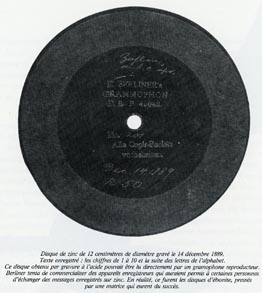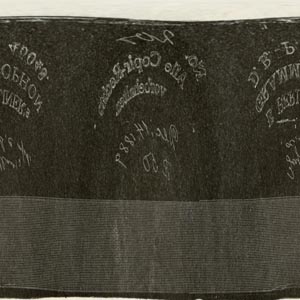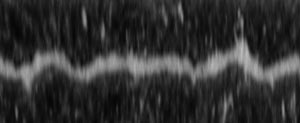 |
Optical Sound Track MethodNOTE: This initial account of methods for transducing images into sound—first posted in 2009—is maintained here for its historical interest. You can also find it archived in Archive.org's Wayback Machine. For current information, please visit griffonage.com. |
[<< Part 2]
3. Spirals3.1—The method described so far works on inscriptions that take the form of straight lines, such as phonautograms (once they've been unwrapped from their cylinders). But what about inscriptions made in the form of spirals, such as gramophone discs? 3.2—You may have seen the following image on page 92 of Paul Charbon's La Machine Parlante:
This image is based on a paper print of a Berliner gramophone disc dated December 14, 1889, and published in a magazine shortly thereafter. In 2008, Stephan Puille drew my attention to this recording and shared with me a 3200 dpi scan he had made from an original print (the Charbon illustration is actually a mirror image). The challenge: could it be made to talk? |
 |
3.3—In order to use ImageToSound on this inscription, it was necessary to convert it from a spiral into a series of straight lines. This can be done in Photoshop using Filter > Distort > Polar Coordinates > Polar to Rectangular. The result looks something like this (illustrating the principle only -- this isn't the version I actually used):
At the bottom of the image we now have fifty-seven lines which can be educed using the same methods described earlier.
I worked out the above method in theory in 2009, but it wasn't until April 2010 that I carried out the actual eduction. Here are the results played at roughly 175 rpm, 87.5 rpm, and 43.75 rpm (also available for download under a creative commons license at Archive.org): We have more to say about this recording and its significance—further research and analysis will soon be forthcoming in print. My purpose here is merely to describe and illustrate the playback method and to make the sound file itself available for listening. |



